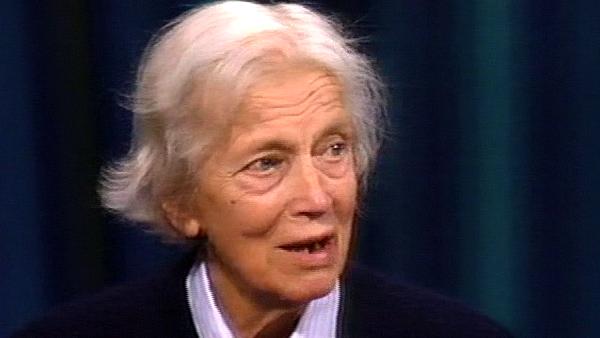NEXT STORY

The beginning of my rheumatoid arthritis
RELATED STORIES

NEXT STORY

The beginning of my rheumatoid arthritis
RELATED STORIES



|
Views | Duration | |
|---|---|---|---|
| 11. More help from my cousin Sir Charles Harrington | 1 | 150 | 02:25 |
| 12. Pink teeth | 190 | 04:30 | |
| 13. Crystallography at Oxford University | 229 | 06:14 | |
| 14. Work on thallium with HM Powell | 142 | 02:30 | |
| 15. Working with JD Bernal in Cambridge | 267 | 04:09 | |
| 16. Photographing pepsin crystals | 208 | 04:54 | |
| 17. The beginning of my rheumatoid arthritis | 320 | 01:32 | |
| 18. Sharing a research student with JD Bernal | 158 | 01:29 | |
| 19. Choosing not to work on defence against chemical warfare | 172 | 01:49 | |
| 20. My first insulin crystals | 206 | 02:20 |


Of course, the most exciting things were the most difficult to work on. And halfway through my expected time at Cambridge, a specimen of pepsin came in, pepsin crystals, very beautiful crystals, from Uppsala in Sweden. They had been made by John Philpot, who was an Oxford chemist-cum-biochemist, that is to say, he wanted to read biology - poor young man - when he came up to the university, but Balliol had a very powerful chemistry tutor, who was Harold Hartley, who insisted he would, it was necessary for him to read chemistry first. But then he did get an appointment in the biochemistry lab, and could begin biochemistry, and he began by going to Scandinavia, and learning how to purify proteins with Tilselius. Well, what came out of this was pepsin, which was seen by another Cambridge friend of Bernal's, on his holiday journeys, one summer these beautiful crystals that John had made were... John was just taking out of the fridge after a holiday during which he had left them growing, and then Glenn Millikan said, well, I know a man in Cambridge who would give his eyes for those crystals. And John said, really friendly-like, well, have a tubeful, and so he put them in his shirt pocket and took them back...
[Q] And they survived?
And they survived in their mother liquor, which is the important part, scientifically, of the story.
[Q] And Bernal looked at those crystals?
He looked at those crystals, and, of course, he immediately wanted to take an X-ray photograph of them, so he raked one out of the tube with a needle onto the glass slide, and then set about mounting it on a glass fibre, which was his usual technique for arranging crystals for X-ray photography. He was a bit worried by it looking a bit shrivelled as it lay there, but he just tried the experiment of passing X-rays through it, and got almost nothing. He decided something must be wrong, and something almost had certainly... the water surrounding, the crystal had no longer water surrounding it, so he had working in the, amongst his research students, one research student, Helen Megaw, who was working on heavy water, and she was, put heavy water in lindemann glass tubes and grow a crystal inside by freezing it, and then photograph it, surrounded by the glass tube. So he borrowed some of her tubes and picked a crystal from the preparation he brought with... he got from John Philpot in its mother liquor into the glass, into the lindemann glass tube, and then sealed it up, and when he took the next photograph, it was full of reflections, rather large, blotchy reflections. I can remember it quite well, which is perhaps something, because it unfortunately seems to have disappeared since.
British pioneer of X-ray crystallography, Dorothy Hodgkin (1910-1994), is best known for her ground-breaking discovery of the structures of penicillin, insulin and vitamin B12. At age 18, she started studying chemistry at Somerville College, Oxford, then one of the University of Oxford colleges for women only. She also studied at the University of Cambridge under John Desmond Bernal, where she became aware of the potential of X-ray crystallography to determine the structure of proteins. Together with Sydney Brenner, Jack Dunitz, Leslie Orgel, and Beryl Oughton, she was one of the first people in April 1953 to see the model of the structure of DNA, constructed by Francis Crick and James Watson. She was awarded the 1964 Nobel Prize in Chemistry and is also known for her peace work with organisations such as Science for Peace and the Medical Aid Committee for Vietnam. All recorded material copyright of The Biochemical Society.
Title: Photographing pepsin crystals
Listeners: Guy Dodson
Guy Dodson studied chemistry and physical science at the University of New Zealand, followed by a PhD on the crystallographic study of an alkaloid. In 1961, he came to Oxford to work on the crystal structure of insulin. In the mid 1970s Guy and his wife moved to York University to establish a laboratory. In addition to insulin studies the laboratory has investigated many complex molecules of medical significance, including haemoglobin, myoglobin, HIV related proteins, proteases and proteins involved in managing nucleic acids in cells. In 1993, he went to the NIMR in London to establish a crystallographic group in an environment that spanned molecular, physiological and disease-related disciplines. Here his research began on some cell signalling proteins. His interests on medically relevant proteins included prions, malarial and TB proteins, and some clinically relevant thrombin inhibitors. Guy Dodson retired in 2004 but is still finding much to do in York and the NIMR.
Tags: John Philpot, JD Bernal
Duration: 4 minutes, 54 seconds
Date story recorded: 1990
Date story went live: 02 October 2009